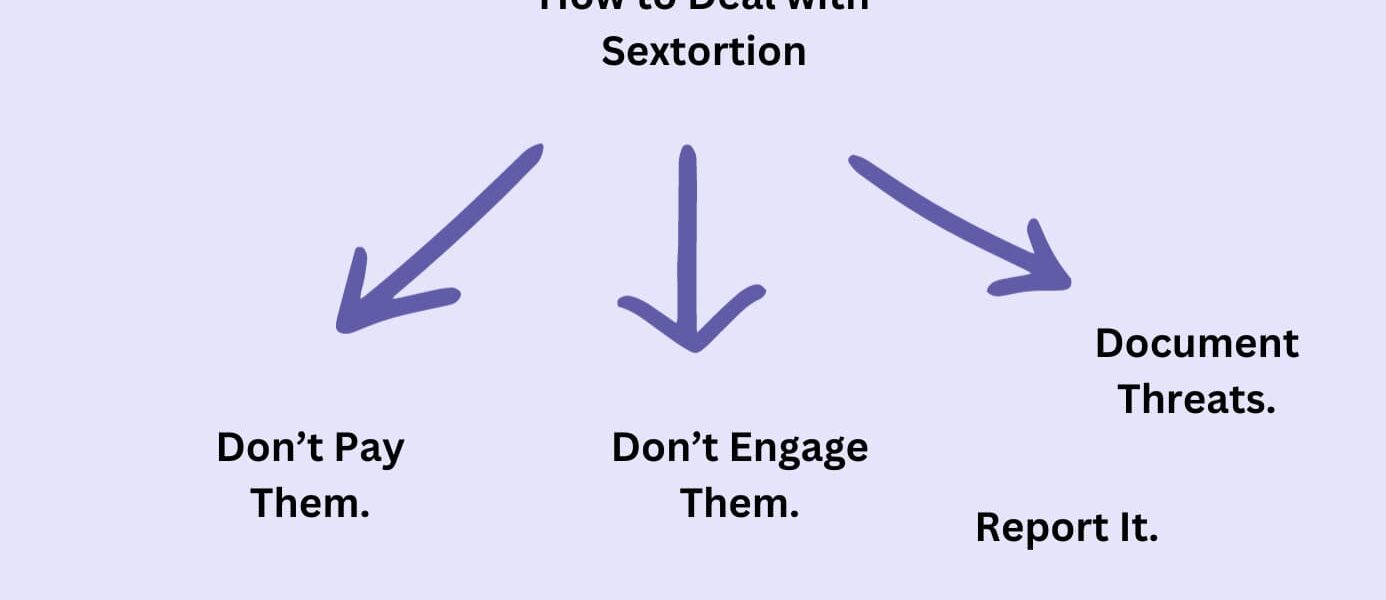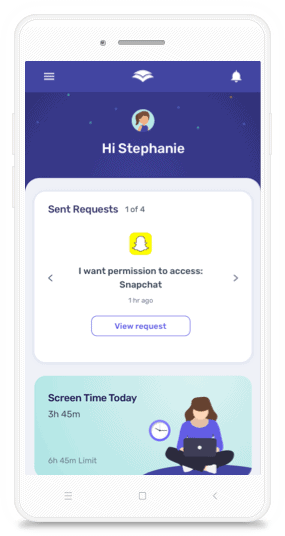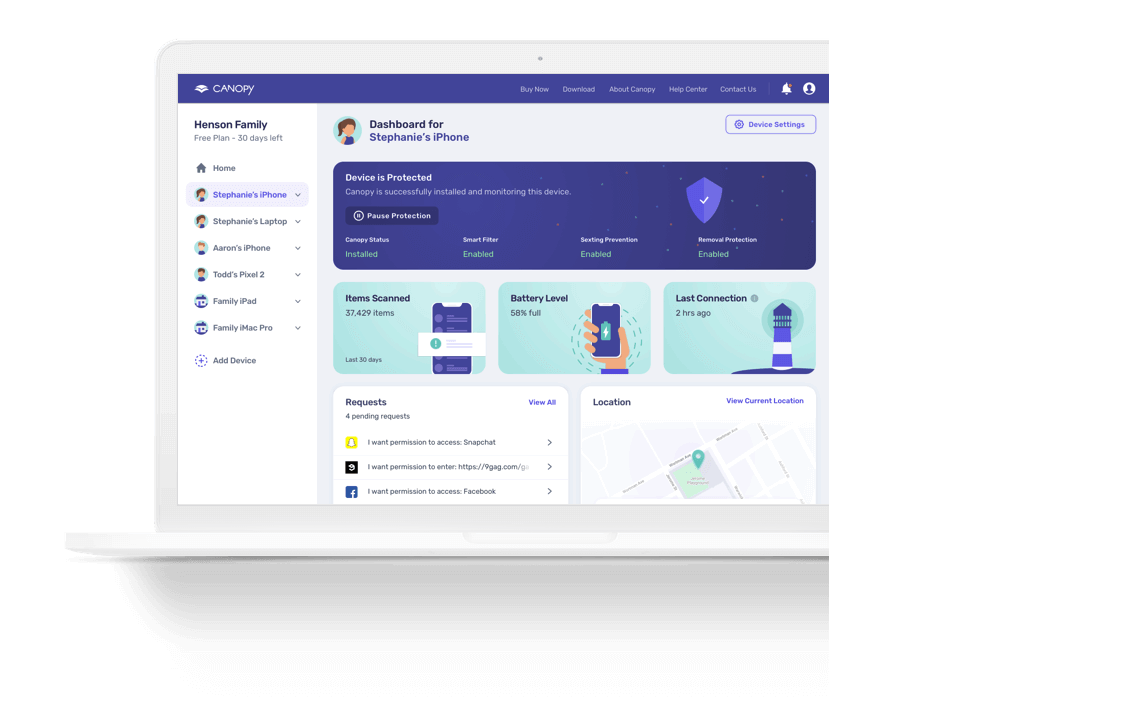Dealing With Sextortion Right Now – 5 First Steps
First, take a deep breath. Being a target of sextortion is soul-crushing. It’s normal to feel anxious, betrayed, and vulnerable. Remember, you’re not at fault. You’re also not as powerless as you feel.
Here’s what you can do right now to take back control:
- Don’t give in to their demands or pay them any money.
- Don’t engage or communicate with them
- Document their extortion/threats with screenshots. You can, and should, block them but do not delete the conversations.
- Report what’s happening. If you’re a teen or child, tell your parents what’s happening. You can decide if you want to contact the police or report elsewhere.
- Don’t blame yourself. Nothing excuses sextortion—even if you did take a naked photo of yourself, they’re in the wrong, not you.
We will explain each of these points in more depth later in this article. But first, you also want to make sure that what you’re experiencing fits the definition of sextortion.
What is sextortion?
Sextortion (also known as sexual extortion) is when someone threatens to share naked and/or sexual imagery of you unless you give into their demands.
Those demands can range from asking for money to pressuring you to send further images.
Sometimes, sextortionists blackmail you with imagery that isn’t real. These images, referred to as deep fake porn, are created using AI. They take innocent photos of you from social media or elsewhere and use them to generate false images and even videos.
Sextortionists can be strangers or someone you know.
Where to report sextortion
Reporting sextortion can prevent the incident from escalating and prevent this person from targeting others.
Extortion of any kind is a crime in the United States. But if the images are of a minor (anyone under 18) then you—or if you’re a parent, your child—could also face legal consequences for possession and distribution of child pornography.
Don’t worry though, there are other organizations you can report to and get help from.
If you’re a minor, report it first to your parents (and show them this article). Together, you can decide who to report to next and whether you should involve the police or FBI.
Here are your options when reporting sextortion:
- If you do decide to get the police involved, go to your local police station (sextortion is urgent but not emergent so it’s better to go in person rather than call 911)
- And/or call the FBI – the FBI encourages sextortion victims to get in touch (call them toll-free at 1-800-CALL-FBI)
- File a complaint with the Internet Crimes Complaint Center (linked to the FBI)
- Submit a report to the National Center For Missing and Exploited Children (NCMEC) – this is for sextortion involving minors
- Or speak to someone at the NCMEC directly by calling this number: 1-800-THE-LOST
- Contact Take It Down – they can help remove nude photos online and prevent them being uploaded altogether
If your sextortionist is reaching you through a social media platform, you can also report them to the app. This could get them blocked permanently.
What should I do if I’m being sextorted or blackmailed? (The 5 steps explained)
Let’s look at the steps you should take as the victim of sextortion or blackmail in more detail:
1. Don’t give in to their demands
As we said before, their demands can range from paying them money to sending further explicit images.
But whatever you do, don’t comply. They may tell you that once you do, they’ll delete the images and leave you alone. It’s much more likely that they’ll continue to blackmail you.
This is especially the case if you pay them. Paying them communicates that you’re willing to give in and that you have a lot to lose in this situation. There’s nothing to incentivize them to delete the images when they could push you to give them more money.
Take it from a sextortion victim who posted about her experience on Reddit:
2. Don’t engage with the sextortionist
It can be tempting to try and reason with the sextortionist if it’s someone you know (and especially if it’s someone you once trusted). It can also be tempting to respond in anger.
But you shouldn’t communicate with this person at all. If you have already, stop.
Responding signals to them that they’ve gotten your attention and can manipulate you.
If they’re spamming you with messages over text or through a social media app, you can block them and change your settings to prevent being tagged or messaged. This takes some of their power away.
That’s because they’ve lost the ability to scare you with threatening messages, and as we discussed before, sextortionists rely on your fear and shame to get what they want.
You might think that ignoring them will only prompt them to follow through on their threats.
But remember, those photos or videos of you are their leverage to getting their demands. If they share them, then they can’t get what they want.
So in most instances, the odds of them following through are slim. However, if they do distribute the photos publicly online or if you think they might, get in touch with a service like ‘Take it Down’.
They can remove and prevent images from being shared on platforms like Facebook, Instagram, TikTok, and porn sites.
3. Document their extortion/threats
When faced with sextortion, your immediate reaction might be to delete everything, to try and erase the threat.
But instead, you should document every interaction.
Start by taking screenshots of all messages, emails, or other forms of communication. If they’ve sent you voice notes or videos, save copies. Make sure to capture any details that might help identify the person, such as usernames, profile pictures, or email addresses.
Having a record of these threats serves multiple purposes. First, it provides evidence if you decide to report the incident to the police or other authorities. Second, it can help online platforms take action against the perpetrator, ensuring they can’t target others.
Store these records in a secure place, either digitally with password protection or physically in a safe location.
If those messages contain the explicit images or video, you can take steps to blur or block out the nudity (especially if you’re a minor).
4. Report sexual extortion
We’ve touched upon how to report sextortion earlier but now let’s go deeper into the why and what of reporting.
Taking action by reporting can be a powerful step in reclaiming your sense of control and ensuring the perpetrator faces consequences.
When reporting, it’s important to:
- Act swiftly. The sooner you report, the better. It can prevent the situation from escalating and stop the sextortionist from targeting others.
- Know the law. In the U.S., extortion is illegal. If the sexual images involve a minor, there could be additional legal implications but those also extend to you as a ‘distributor’ of the content. If this is a concern, contact the National Center For Missing and Exploited Children.
- Talk to someone. If you’re a minor, confide in your parents. They can support you in deciding the next steps. If you’re an adult, consider seeking advice from trusted friends or professionals.
- Explore your options. Whether it’s your local police, the FBI, the Internet Crimes Complaint Center, or the National Center For Missing and Exploited Children, there are multiple avenues to report sextortion. Platforms like ‘Take It Down’ can also assist in removing explicit content shared online.
- Protect your online space. If the threats come via social media or messaging apps, use the platform’s reporting features. It can lead to the sextortionist being blocked or banned.
Just remember, you’re not alone in this.
There are resources and support systems in place to help you navigate and overcome sextortion.
That’s true whether it’s figuring out how to deal with sextortion on Snapchat, Instagram, Facebook, or anywhere else sextortion may strike.
5. Don’t blame yourself
When it comes to sextortion, it’s vital to understand one thing: this is not your fault.
Sextortionists manipulate emotions, exploit trust, and use fear as a weapon. Whether you shared a photo willingly or were deceived into it, the blame lies squarely with the person using that image against you.
It’s easy to get caught in a cycle of self-blame, thinking things like, “I shouldn’t have taken that photo,” or “I should’ve been more careful.” But remember, everyone has moments of trust, vulnerability, and desire for connection. It’s what makes us human and we’re all on your side here.
Seek support from friends, family, or professionals who can help you process your feelings and reinforce the truth: you are a victim in this situation, and the blame is not yours to bear.
And if you’re a parent helping your child in this situation, make sure you reinforce this point.
How to Prevent Sextortion Moving Forward (4 Ways)
Now that you know how to deal with sextortion, let’s make sure it never happens again.
Below we’ve listed our top tips to preventing sextortion and have included guidance for both parents and teens.
1. Don’t Sext
Sexting is often what leads to sextortion. The moment someone else has a sexual image or video of you is the moment they can use it against you.
It’s best to avoid it altogether and to stand firm when someone asks or pressures you to engage in sexting.
Tips for teens:
Understand the risks: Once an image or message is sent, you lose control over it. Even if you trust the recipient now, relationships change, and that image could end up in the wrong hands.
Think about the future: What seems like a fleeting moment now could have long-term consequences for personal relationships, reputation, or even future job prospects.
Tips for parents:
Open the conversation: Talk to your child about the dangers and implications of sexting. Use real-life examples or news stories to illustrate the risks.
Use tools like Canopy: Canopy’s sexting prevention tool can act as a safety net, alerting you if your child has taken or received explicit photos on their device.

→ Grab a free trial of Canopy and prevent sexting from taking place. ←
2. Be wary of ‘Danger Zones’ – Social Media and Other Platforms
With AI tools, even innocent posts on socials are at risk of being used in sextortion. We recommend blocking use of social platforms to prevent this from happening at all but we also have tips for when social media can’t be avoided.
Tips for teens:
Be selective: Not every friend request or follow needs to be accepted. Only connect with people you know and trust.
Review privacy settings: Ensure your profiles are private and that you’re sharing content only with trusted friends and family.
Tips for parents:
Stay informed: Familiarize yourself with the platforms your child uses. Understand the risks associated with each one.
Monitor and control: Use tools like Canopy to block or limit access to certain apps and websites, ensuring your child’s online environment remains safe.
Periodically check your child’s social media accounts to ensure they’re using them safely and responsibly.
We have some guides to help you block specific websites and social media apps:
- How to block adult content on Facebook
- How to block adult content on Twitter
- How to block TikTok on phone (iPhone and Android)
- How to block inappropriate content on Snapchat
3. Be cautious with online interactions and posts
Sharing personal details or casual posts might seem harmless, but every piece of information you put out there can be used, manipulated, or taken out of context.
Be vigilant and cautious about all online interactions and people who contact you, especially if you don’t know them in real life.
Tips for teens:
Think before you post: Every image, video, or status you share becomes a part of your digital footprint. Ask yourself if it’s something you’d be comfortable with everyone seeing, including future employers or college admissions officers.
Guard your privacy: Be wary of sharing personal details like your address, school, phone number, or other identifying information.
Tips for parents:
Educate about oversharing: Talk to your child about the risks of sharing too much online. Use real-life examples to illustrate the potential dangers.
Set boundaries: Establish rules about what’s acceptable to post and what isn’t. Discuss the reasons behind these boundaries to ensure understanding.
4. Communicate Concerns Openly
Communicating our concerns with those we trust can bring dangerous situations to light before they escalate into something real.
Tips for teens:
Speak up: If something feels off or you’re unsure about an online interaction, talk to someone you trust. It’s always better to be safe than sorry.
Remember, it’s okay to say no: If someone pressures you for images or personal information, stand your ground and refuse.
Tips for parents:
Create a safe space: Ensure your child knows they can come to you with any concerns or questions about their online interactions without fear of punishment.
Educate and empower: Share resources and stories that can help your child understand the importance of online safety.
“Open, honest discussions with your child can prevent them from being ultimately exposed to such threats as sextortion and revenge porn. Barring that, Canopy acts as your last line of defense in preventing sexting – and it will sound the alarm for you, so you can step in and intervene with your child before they make what could be the biggest mistake of his or her life.” Canopy Executive, Yaron Litwin |
Get started with a free trial of Canopy to protect your children online and limit the chances of sextortion.





